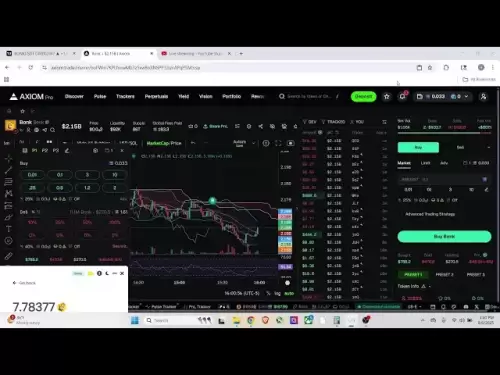-
 Bitcoin
Bitcoin $116700
2.16% -
 Ethereum
Ethereum $3830
5.76% -
 XRP
XRP $3.082
4.56% -
 Tether USDt
Tether USDt $1.000
0.04% -
 BNB
BNB $777.8
1.96% -
 Solana
Solana $173.2
5.46% -
 USDC
USDC $0.0000
0.02% -
 Dogecoin
Dogecoin $0.2146
6.85% -
 TRON
TRON $0.3384
0.92% -
 Cardano
Cardano $0.7676
5.51% -
 Hyperliquid
Hyperliquid $39.28
4.90% -
 Sui
Sui $3.723
9.07% -
 Stellar
Stellar $0.4164
6.32% -
 Chainlink
Chainlink $17.36
5.78% -
 Bitcoin Cash
Bitcoin Cash $580.9
3.62% -
 Hedera
Hedera $0.2544
5.50% -
 Ethena USDe
Ethena USDe $1.001
0.02% -
 Avalanche
Avalanche $22.81
3.81% -
 Litecoin
Litecoin $120.8
3.60% -
 UNUS SED LEO
UNUS SED LEO $8.956
-0.35% -
 Toncoin
Toncoin $3.311
4.28% -
 Shiba Inu
Shiba Inu $0.00001266
4.15% -
 Uniswap
Uniswap $10.10
5.97% -
 Polkadot
Polkadot $3.786
4.80% -
 Dai
Dai $1.000
0.01% -
 Monero
Monero $280.4
-4.02% -
 Bitget Token
Bitget Token $4.405
1.69% -
 Cronos
Cronos $0.1480
5.13% -
 Pepe
Pepe $0.00001087
5.67% -
 Ethena
Ethena $0.6348
11.62%
What are the buying and selling strategies for SOL in a bull market?
In a Solana bull market, use DCA, buy on dips, and set profit targets to maximize returns; employ technical indicators and maintain emotional discipline for effective trading.
Apr 20, 2025 at 02:01 pm

In a bull market, the cryptocurrency Solana (SOL) often experiences significant price appreciation, making it an attractive asset for traders and investors. Understanding effective buying and selling strategies for SOL during such periods can help maximize returns and minimize risks. This article delves into various strategies that can be employed to navigate the bull market effectively.
Identifying the Bull Market
Before diving into specific strategies, it's crucial to identify when a bull market is in place. A bull market for SOL can be recognized by a consistent upward trend in its price over a period, usually accompanied by increased trading volumes and positive sentiment within the crypto community.
- Monitor price charts to observe the trend. A series of higher highs and higher lows typically indicates a bull market.
- Analyze trading volumes as higher volumes during price increases can confirm the strength of the bull market.
- Follow market sentiment through social media, news outlets, and crypto forums to gauge the general mood.
Buying Strategies in a Bull Market
Dollar-Cost Averaging (DCA)
Dollar-Cost Averaging is a strategy where you invest a fixed amount of money at regular intervals, regardless of the price of SOL. This approach helps mitigate the risk of investing a large amount at a peak price.
- Choose a fixed amount to invest in SOL, say $100 per week.
- Set up automatic purchases to buy SOL at the same time each week.
- Continue this strategy over the bull market period, which allows you to buy more SOL when the price is low and less when it's high, averaging out the cost.
Buying on Dips
Another effective strategy during a bull market is to buy on dips. This involves purchasing SOL when its price temporarily drops within the overall upward trend.
- Identify short-term price drops within the bull market using technical analysis tools like moving averages and support levels.
- Set buy orders slightly above the identified support levels to ensure you purchase SOL at a favorable price.
- Be prepared to act quickly, as these dips can be short-lived in a strong bull market.
Using Technical Indicators
Technical indicators can help you time your purchases more effectively. Popular indicators for SOL trading include the Relative Strength Index (RSI), Moving Average Convergence Divergence (MACD), and Bollinger Bands.
- Use the RSI to identify when SOL is oversold (below 30) or overbought (above 70). Buying when the RSI is below 30 can signal a good entry point.
- The MACD can help confirm bullish trends. Look for the MACD line crossing above the signal line as a buy signal.
- Bollinger Bands can indicate volatility and potential price reversals. Buying near the lower band during a bull market can be advantageous.
Selling Strategies in a Bull Market
Setting Profit Targets
One of the simplest yet effective selling strategies is to set profit targets. This involves deciding in advance at what price levels you will sell your SOL to lock in profits.
- Determine your profit targets based on your risk tolerance and investment goals. For example, you might aim for a 20%, 50%, or 100% return.
- Set sell orders at these target levels to automatically execute when the price is reached.
- Consider scaling out of your position by selling portions of your SOL at different profit targets to balance risk and reward.
Trailing Stop Losses
Trailing stop losses are a dynamic way to protect your profits while allowing for further upside potential. This strategy adjusts your stop loss as the price of SOL increases.
- Set a trailing stop loss percentage or price level. For example, you might set a 10% trailing stop loss.
- As the price of SOL rises, the stop loss level will move up, locking in more profits.
- If the price of SOL falls by the specified percentage, the trailing stop loss will trigger a sell order, helping you exit the position with a profit.
Selling on Overbought Signals
Using technical indicators to identify overbought conditions can also guide your selling decisions. When SOL is overbought, it may be a good time to take profits.
- Monitor the RSI. When it rises above 70, it indicates that SOL may be overbought, and a price correction could be imminent.
- Use the MACD to look for bearish signals, such as the MACD line crossing below the signal line.
- Bollinger Bands can also indicate overbought conditions when the price touches or exceeds the upper band.
Risk Management
Effective risk management is crucial in any trading strategy, especially during a bull market when emotions can run high.
- Diversify your portfolio to spread risk across different assets.
- Use stop-loss orders to limit potential losses if the market suddenly turns bearish.
- Regularly review and adjust your strategies based on market conditions and your performance.
Emotional Discipline
Maintaining emotional discipline is vital when trading SOL in a bull market. Greed and FOMO (Fear of Missing Out) can lead to poor decision-making.
- Stick to your predetermined strategies and avoid making impulsive trades.
- Take breaks from constant market monitoring to reduce stress and maintain a clear mind.
- Keep a trading journal to reflect on your decisions and learn from your experiences.
Frequently Asked Questions
Q: How can I tell if a bull market for SOL is about to end?
A: Signs that a bull market for SOL might be ending include a series of lower highs and lower lows on the price chart, decreasing trading volumes during price increases, and a shift in market sentiment from bullish to bearish. Additionally, technical indicators like the RSI moving out of overbought territory and the MACD showing bearish signals can indicate a potential end to the bull market.
Q: Is it safe to use leverage when trading SOL in a bull market?
A: Using leverage can amplify both gains and losses. While it can be tempting to use leverage in a bull market to increase potential returns, it also increases risk. It's important to use leverage cautiously, understand the risks involved, and have a solid risk management plan in place.
Q: Can I use the same strategies for other cryptocurrencies during a bull market?
A: While the strategies discussed can be applied to other cryptocurrencies, each asset may have unique characteristics and market dynamics. It's essential to conduct thorough research and adjust your strategies based on the specific cryptocurrency you are trading.
Q: How important is it to stay updated with SOL news and developments during a bull market?
A: Staying updated with SOL news and developments is crucial during a bull market. Positive news and developments can drive the price higher, while negative news can lead to corrections. Keeping informed helps you make more informed trading decisions and stay ahead of market movements.
Disclaimer:info@kdj.com
The information provided is not trading advice. kdj.com does not assume any responsibility for any investments made based on the information provided in this article. Cryptocurrencies are highly volatile and it is highly recommended that you invest with caution after thorough research!
If you believe that the content used on this website infringes your copyright, please contact us immediately (info@kdj.com) and we will delete it promptly.
- BlockchainFX, Bitcoin Swift, Crypto Presales: What's the Hype?
- 2025-08-07 19:10:13
- SHIB Community at Crossroads: Shytoshi Kusama's Leadership Under Scrutiny as Elections Loom
- 2025-08-07 18:30:13
- IREN Overtakes: A New King in the Bitcoin Miner Hashrate Race?
- 2025-08-07 16:31:29
- Memecoins Mania: Whales Eye Pepe Dollar (PEPD) as Bonk Cools Off, While MoonBull Hogs the Spotlight!
- 2025-08-07 16:51:17
- Unilabs, PEPE, and Investment Risk: Navigating the Crypto Hype
- 2025-08-07 16:31:29
- Meme Coin Mania: Rug Pulls, CZ-Inspired Tokens, and the Wild West of Crypto
- 2025-08-07 16:57:14
Related knowledge

How to avoid common crypto investment mistakes?
Jul 13,2025 at 01:35am
Understanding the Risks of Crypto InvestmentInvesting in cryptocurrency can be highly rewarding, but it also comes with significant risks. One of the ...

What is a long-short crypto strategy?
Jul 15,2025 at 10:56am
Understanding the Basics of a Long-Short Crypto StrategyA long-short crypto strategy is an investment approach where traders simultaneously take long ...

What is a long-short crypto strategy?
Jul 11,2025 at 01:28pm
Understanding the Basics of Long-Short Crypto StrategyA long-short crypto strategy is an investment approach where traders take both long and short po...

How to use the RSI indicator for crypto?
Jul 12,2025 at 03:56pm
Understanding the RSI Indicator in Cryptocurrency TradingThe Relative Strength Index (RSI) is a momentum oscillator used to measure the speed and chan...

Is copy trading a good strategy for crypto beginners?
Jul 12,2025 at 08:28am
Understanding Copy Trading in the Cryptocurrency MarketCopy trading is a strategy where novice traders replicate the trades of experienced investors a...

How to build a crypto portfolio with $1000?
Jul 13,2025 at 08:14pm
Understanding the Basics of Cryptocurrency InvestmentBuilding a crypto portfolio with $1000 starts with understanding the fundamentals of cryptocurren...

How to avoid common crypto investment mistakes?
Jul 13,2025 at 01:35am
Understanding the Risks of Crypto InvestmentInvesting in cryptocurrency can be highly rewarding, but it also comes with significant risks. One of the ...

What is a long-short crypto strategy?
Jul 15,2025 at 10:56am
Understanding the Basics of a Long-Short Crypto StrategyA long-short crypto strategy is an investment approach where traders simultaneously take long ...

What is a long-short crypto strategy?
Jul 11,2025 at 01:28pm
Understanding the Basics of Long-Short Crypto StrategyA long-short crypto strategy is an investment approach where traders take both long and short po...

How to use the RSI indicator for crypto?
Jul 12,2025 at 03:56pm
Understanding the RSI Indicator in Cryptocurrency TradingThe Relative Strength Index (RSI) is a momentum oscillator used to measure the speed and chan...

Is copy trading a good strategy for crypto beginners?
Jul 12,2025 at 08:28am
Understanding Copy Trading in the Cryptocurrency MarketCopy trading is a strategy where novice traders replicate the trades of experienced investors a...

How to build a crypto portfolio with $1000?
Jul 13,2025 at 08:14pm
Understanding the Basics of Cryptocurrency InvestmentBuilding a crypto portfolio with $1000 starts with understanding the fundamentals of cryptocurren...
See all articles

























































































